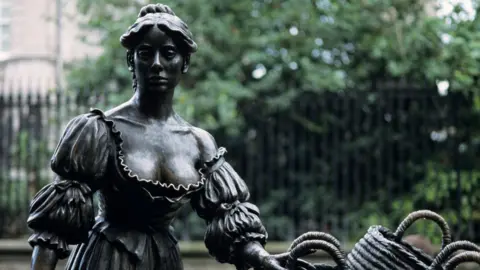Dublin's Molly Malone statue to get stewards to stop 'groping'
 Getty Images
Getty ImagesStewards are to be stationed next to a statue of Molly Malone in Dublin to discourage people from touching it.
Dublin City Council is running a pilot scheme for a week in May after complaints of people groping the sculpture's breasts.
The council also said it has plans to re-patinate (re-cover) parts of the statue that have become discoloured by people touching it.
"Dublin City Council do not want anyone to touch any work of art whether indoors or outdoors to avoid damage and costly repairs," a spokesperson said.
"The low plinth height and space around the statue allows crowds to congregate easily and the Molly Malone statue is a feature of tours given by tour guides."
 Getty Images
Getty ImagesThe council said other potential options to stop people touching the statue such as moving it or raising the plinth that it sits on are "under review".
However, it said that these options would be "costly", adding that placing a railing around the artwork "may increase risk".
"A pilot week of stewarding will occur in May to begin educating those who are interacting with the statue and requesting they do not touch the statue or step on the plinth and discussing the reasons for not doing so," the council statement said.
Tilly Cripwell, a student who has campaigned for the statue to be treated with more respect, criticised the idea of stewards as "short sighted and quite short term".
However, she welcomed the planned restoration work as an "important advancement".
She told the BBC's Good Morning Ulster programme that she hoped behaviours would change "and if not [the statue should] potentially raised on a plinth".
She also called for a plaque to be installed to explain the legacy of Molly Malone.
Who was Molly Malone?
 Getty Images
Getty ImagesThe Molly Malone statue was erected 37 years ago in tribute to a legendary Dublin woman who sold shellfish in the streets of the Irish capital.
It is not clear if the character is based on a real or fictional person, but the figure of Molly Malone has come to represent part of Dublin's working class community.
She was also the subject of a traditional folk song, which tells the story of a fishmongers' daughter who sold cockles and mussels from a wheelbarrow.
According to the colourful lyrics, Molly died of a fever but then returned as a ghost, still wheeling her wheelbarrow through the city's streets.
Many public artworks in Dublin are popularly referred to by rhyming nicknames and for years, the Molly Malone statue was known as "the tart with the cart".
This name was in part due to suggestions that Molly Malone worked as a fishmonger by day and as a sex worker by night.
The statue was first erected in Dublin's Grafton Street in 1988, created by the renowned bronze sculptor, Jeanne Rynhart.
It was later moved to nearby St Andrews' Street to accommodate the construction of a tram line.
